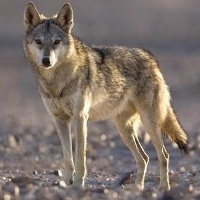 |
Egyptian wolf |
|
He is a wild animal |
Origin |
North Africa | |
Translation |
Francis Vandersteen |
| The possession of this animal is not authorized Royal Decree establishing the list of mammals not kept for production purposes that may be kept (M.B. 24.08.2009) |
| W.F. Hemprich and C.G. Ehrenberg first recognized the Egyptian wolf's similarity to Canis lupus in 1833. Consequently, it was given the name Canis lupaster. As early as 1880, biologist Thomas Huxley declared that the Egyptian wolf bore an uncanny resemblance to a gray wolf. It was recently classified as a subspecies of the Golden Jackal Canis aureus lupaster in 1926 by Ernst Schwarz. Fairly recent studies of this Egyptian wolf have shown morphological differences from other subspecies and characteristics that bring it closer to the Canis lupus species. However, because study data were so scarce, the conclusion was to retain the Egyptian wolf as a subspecies of Canis aureus. If it were ever a subspecies of Canis lupus, it would be the only known grey wolf in Africa. Canis aureus lupaster, also known as Egyptian wolves, are found only in northern Egypt, the Ethiopian highlands and northeastern Libya. They may still be found in Saudi Arabia, but hunting has considerably reduced their numbers. Appearing large, the Egyptian wolf measures 1.30 to 1.63 m in length from tip of nose to tip of tail, stands 40 to 51 cm at shoulder height and weighs 10 to 16 kg. It is rather slender, with a coat that is generally tinged with gray, beige or dirty yellow. It is often described as gangly and may appear heavier than its actual weight. It is larger and longer than other wolf subspecies, although smaller than the Arabian wolf. These wolves are generally nocturnal. Like other wolves, they usually bark when excited or growl when irritated. They usually howl or yell at each other just after dark and just before sunrise. They will give an occasional bark. They are very sociable and usually live in packs or, more often, pairs. The Egyptian wolf is an omnivorous creature, feeding on insects, snails, fish, chickens, young goats, sheep, birds and carrion, as well as melons and corn. Mating takes place in early spring, with a gestation period of around two months. They will usually have around four or five puppies. However, they have recorded up to eight. It was classified as critically endangered by the International Union for Conservation of Nature. Then suddenly in January 2011, it was no longer listed anywhere by the IUCN. There are perhaps no more than forty in the world. |






 English (United Kingdom)
English (United Kingdom)